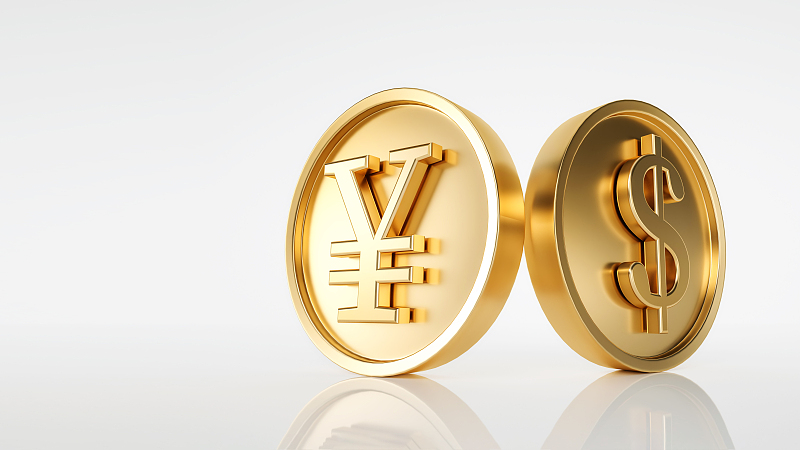
Editor's note: Djoomart Otorbaev, a special commentator on current affairs for CGTN, is the former prime minister of the Kyrgyz Republic, a distinguished professor of the Belt and Road School of Beijing Normal University, a member of Nizami Ganjavi International Centre, and the author of the book "Central Asia's Economic Rebirth in the Shadow of the New Great Game"(Routledge, 2023). The article reflects the author's views and not necessarily those of CGTN.
Over the past 50 years, the Chinese economy has grown at an impressive rate, becoming the second largest in the world. The country is the world's largest exporter and trading partner for most countries. However, its national currency, the yuan, still lags behind its use in international trade.
China just passed another milestone in its quest to reduce dependence on the U.S. dollar as the use of the yuan in its cross-border transactions in the second quarter of this year surpassed American currency for the first time. The local currency's share of China's cross-border payments and receipts rose to a record 49 percent at the end of June from near zero in 2010. The share of the dollar fell to 47 percent from 83 percent in the same period. This significant achievement highlights China's thriving economy and its increasing financial influence.
Notably, the yuan has risen from its previous place at 35th in 2001 to become the fifth most traded currency globally. It has also improved in ranking for global payments, currently holding the fifth position after the U.S. dollar, the euro, the British pound, and the Japanese yen. In 2011, it was at 30th position.
Although the Chinese yuan only accounts for 2.77 percent of global payments, compared to the dollar's 42.02 percent and the euro's 31.25 percent, its share is increasing as it was at around 1.8 percent five years ago.
Additionally, at the close of last year, the yuan made up less than 3 percent of worldwide foreign exchange reserves, while the dollar accounted for 59 percent and the euro for 20 percent.
The Chinese government has been actively trying to increase the yuan's global use. One such example is the launch of the Cross-Border Interbank Payment System (CIPS) in 2015. In 2018 it launched the world's first yuan-denominated crude oil futures contracts. China's central bank is actively developing the digital yuan, which is set to be one of the first digital currencies in the world.

An electronic board shows the currency exchange rates in Moscow, Russia, July 4, 2023. /CFP
An electronic board shows the currency exchange rates in Moscow, Russia, July 4, 2023. /CFP
The Russian military operation in Ukraine has had a major impact on the dollar's role in international settlements. In response, the U.S. and its Western allies have imposed tough economic sanctions on Russia, stopping their access to the dollar-based global payment system, SWIFT. Additionally, Western countries announced they would seize Russian assets valued at hundreds of billions of dollars, including government-guaranteed U.S. and European treasury bills investments.
Recent events have shown that the dollar has been transformed from a technical medium of exchange into an aggressive political weapon. Consequently, several nations opt to reduce their investments in U.S. treasury bills and, instead, are building up their gold reserves. They also choose to conduct their bilateral trade using their respective local currencies.
Russia had no choice but to start using other currencies in international trade. It began receiving payments for oil, gas, and coal in yuan, besides Moscow sharply increased the yuan holdings in its foreign exchange reserves. Major Russian companies, such as Rosneft, have issued yuan bonds. According to Bloomberg, the yuan is now the most traded currency in Russia.
After Russia started actively using the yuan, other countries realized the advantages and saw a chance to decrease their reliance on the dollar, leading to a chain reaction. Earlier this year, Beijing signed bilateral agreements with Brazil for soybean supply. It allows direct exchange between the yuan and the Brazilian real. In April, Argentina announced its shift from using dollars to yuan for its imports from China.
India uses non-dollar currencies, such as UAE dirhams and Russian rubles, to pay for most of the Russian oil they import. Similarly, Bangladesh has started paying Russia in yuan for constructing a nuclear power plant. Iraq intends to use yuan as payment currency for its imports from China. France has begun accepting yuan as payment for liquefied natural gas purchased from a Chinese state oil company.
The upcoming BRICS summit, scheduled for August in South Africa, is expected to discuss applications from several influential countries seeking to join the organization. Now it is noticeable that the summit participants are ready to support introducing an independent currency as an alternative to the U.S. dollar. Among the contenders for this role is the yuan since China's GDP is 71 percent of the current pool. In the competition for currency influence, it is fitting to recall the famous quote from the great hockey player Wayne Gretzky: "Skate where the puck will be, not where it was."
(If you want to contribute and have specific expertise, please contact us at opinions@cgtn.com. Follow @thouse_opinions on Twitter to discover the latest commentaries in the CGTN Opinion Section.)